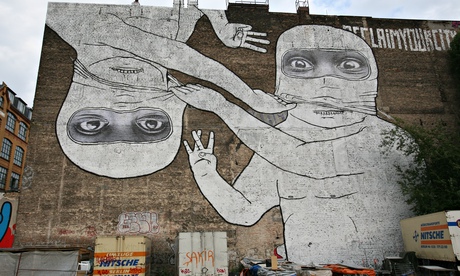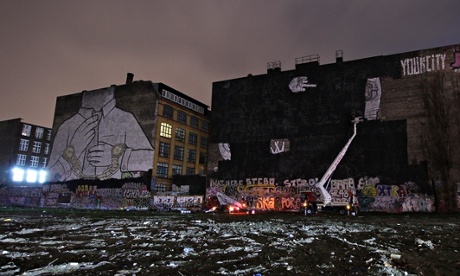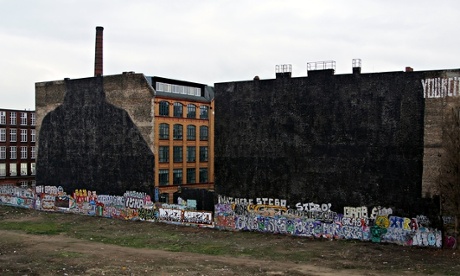Why we painted over Berlin’s most
famous graffiti
Berlin’s gentrification and zombification is in full swing. We would rather destroy our street art than let it contribute to that process

The sound of a megaphone shrills through the cold Berlin night air. Some passersby yell at us in anger. Others silently wipe tears off their cheeks. “It’s the first time in my career as an artist that somebody is booing me,” says a voice next to me. We stop painting for a moment to watch the small crowd that has gathered on the other side of the fence, about 25 meters beneath our lifting platform. But there’s little time for introspection: almost 1,000 sq m of brick wall still needs to be covered with black paint by tomorrow morning.
Last week, from late Thursday night to early Friday morning, I and several others painted over two murals by Italian artist Blu in Kreuzberg, often referred to as Berlin’s most iconic street art. Since then, the German capital has been full of speculation as to who did this and why. Many assumed that property developers had killed off their beloved mural, and few realized that the people behind it were the ones who created it in the first place. So we have decided to tell our side of the story.
Seven years after the monumental wall pieces came into being, we felt it was time for them to vanish, along with the fading era in Berlin’s history that they represented. The story of the mural is directly linked to the history of this district of the city, which used to border directly on to East Germany. The first piece, a collaboration between Blu and French artist JR, depicts two figures in the act of unmasking each other, showing the “east side” and “west side” gang signs. In 2008, Blu and I had decided to renovate the two figures, but instead spontaneously added a second mural on a wall next to them: a businessman chained by his golden watches.

These pieces boldly claimed worldwide attention, becoming what Siegfried Kracauer in 1930 described as Raumbilder: unconsciously produced spatial images which are the “dreams of society”. Unintentionally, we had created an ideal visual representation of the imaginary Berlin of the noughties and its promises: a city full of wasteland offering plenty of space for affordable living and creative experimentation among the ruins of its recent history.
These features became the main attractions and the mantra of the recently departed mayor Klaus Wowereit’s notorious “poor but sexy” Berlin. The murals took their involuntary place in this reality as a pilgrimage site of guided street art tours, as a photo opportunity for countless greeting cards, book covers and record sleeves. The city started to use the aesthetics of resistance for its marketing campaigns.
But by this time the neighborhood had already found itself in the thick of gentrification, with fierce protests against rising rents. And of course art – especially highly visible public art, just think of Banksy – contributes to this process.
While Berlin on the one hand prides itself on its art scene, its failed urban development and cultural policy squandered much of the city’s rare spatial potential, and thereby also jeopardized the existence of its main attraction – the artists. They found themselves to be their own biggest enemies, contributing to their own displacement.

Gentrification in Berlin lately doesn’t content itself with destroying creative spaces. Because it needs its artistic brand to remain attractive, it tends to artificially reanimate the creativity it has displaced, thus producing an “undead city”. This zombification is threatening to turn Berlin into a museal city of veneers, the “art scene” preserved as an amusement park for those who can afford the rising rents.
Still, why would an artist agree to destroy his own work instead of endorsing official attempts to preserve it as a public work of art? Out of despair? Clearly not. Rather out of sorrow. From the first moment of their existence, Blu’s murals were doomed to disappear. It is the nature of street art to occupy space in celebration of its uncertainty, being aware of its temporality and fleeting existence.
However, for me the white- – well, in this case black- – washing also signifies a rebirth: as a wake-up call to the city and its dwellers, a reminder of the necessity to preserve affordable and lively spaces of possibility, instead of producing undead taxidermies of art. It stresses the social function of artistic interventions where others fail to advance.

No comments:
Post a Comment